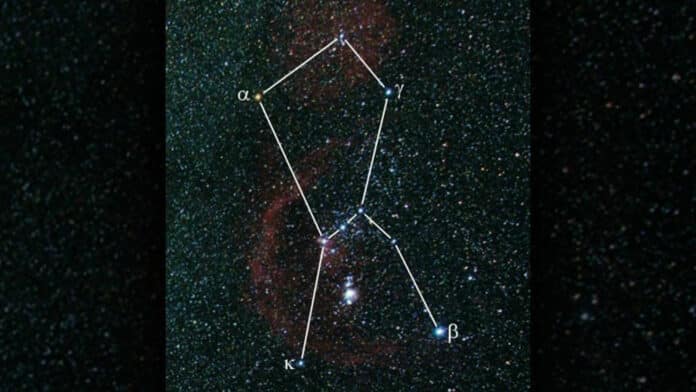After core hydrogen burning, massive stars evolve from blue-white dwarfs to red supergiants by expanding, brightening, and cooling within a few millennia. At the same time, the star’s- brightness, size, and color also change.
By deriving the age and mass of a star, astronomers can get important information on such properties. Astrophysicists of Friedrich Schiller University Jena, Germany, together with colleagues of other subjects from the USA and Italy, have successfully detected and dated such a color change in a bright star: red giant Betelgeuse.
By analyzing data from several sources, they found that Betelgeuse – the bright red giant star in the upper left of the constellation Orion – was yellow-orange some 2,000 years ago.
The Chinese court astronomer Sima Qian wrote around 100 BC about star colors: white is like Sirius, red is like Antares, yellow is like Betelgeuse, and blue like Bellatrix.
Prof. Ralph Neuhäuser from the University of Jena said, “From these specifications, one can conclude that Betelgeuse at that time was in color between the blue-white Sirius and Bellatrix and the red Antares.”
In addition to the foregoing, the Roman scholar Hyginus claimed that Betelgeuse had a color similar to that of yellow-orange Saturn some 100 years later. As a result, one can measure the former color of Betelgeuse with even greater accuracy. More ancient writers, including Ptolemy, provide evidence that Betelgeuse, at their time, did not belong to the group of bright red stars that also included Antares (in the constellation Scorpio), Aldebaran, and others (in Taurus, the Bull).
Neuhäuser noted, “The Greek name Antares means “like Mars “in color; it was indeed reported as red and compared to Mars for millennia from cultures around the world. From a statement by the Danish astronomer Tycho Brahe, one can conclude that, in the 16th century, Betelgeuse was more red than Aldebaran. Today, Betelgeuse is comparable in brightness and color to Antares.”
This new analysis includes historical celestial observations and collaboration with languages, history, and natural philosophy experts.
Neuhäuser said, “The view back in time delivers strong impulses and important results, which can hardly be solved without historical observations.”
“The fact that it changed in color within two millennia from yellow-orange to red tells us, together with theoretical calculations, that it has 14 times the mass of our Sun – and the mass is the main parameter defining the evolution of stars. Betelgeuse is now 14 million years old and in its late evolutionary phases. In about 1.5 million years, it will finally explode as a supernova.”
Journal Reference:
- Neuhäuser, G. Torres, M. Mugrauer, D. L. Neuhäuser, J. Chapman, D. Luge, M. Cosci: Colour evolution of Betelgeuse and Antares over two millennia, derived from historical records, as a new constraint on mass and age, MNRAS, 2022. DOI: 10.1093/mnras/stac1969
